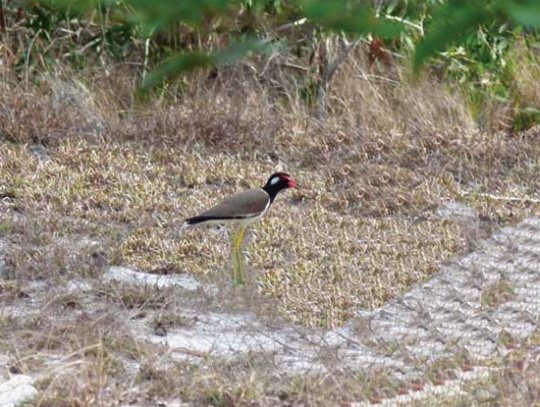Sand creatures
Thinking that it is difficult for any creature to survive in the sand burns, among the dunes that form and disappear with the waves of the sea, there are still creatures that adapt to that harsh environment - one in the secrets of nature .
Hidden behind the tall sand dunes close to the sea are cajuput forests, oil forests or deciduous forests on the sand. This is a unique forest type unique in Vietnam, in the nature reserve Binh Chau Phuoc Buu (Xuyen Moc district, Ba Ria - Vung Tau province). During the actual filming tour of Supereme Master TV with the program that broadcast more than 160 languages around the world about Ngo Van Tri - Leiolepis ngovantrii Grismer & Grismer, 2010, one of ten animal species The bizarre object discovered in 2010 was voted by the National Geographic Association in May last year, we have conditions to further examine the sandy life of many species.
The author and the film crew buried themselves in the sand dunes, when exposed to the burning sun of the sandy area, can record the close-up of their wild life.
Vanallus indicus - Vanallus indicus

Te er has a slender body, about 30cm high. The adult bird's body is black on the top of the neck and upper chest, contrasting with the white underneath, with two white spots behind the eyes and two white strips running around the neck after linking with the abdomen, the red mine with the black tip, males are red on the top of the head, gray-brown back, yellow legs.
Te te is one of the most noisy birds in the sand area. Their names are true to the sounds they emit: 'te . te . er'. Te er usually live and nest in sandy areas or sandy beaches alternating between forest habitats. When guarding eggs and territories, this bird does not mind colliding with intruders including humans. When they discovered a stranger, they screamed and screamed as long as they were bored!
Halcyon chloris - Halcyon chloris
White lemongrass on the back and tail is blue, neck and abdomen are white, black beak.

This is one of the most common birds in coastal mangroves. This lemongrass only feeds in the early morning or late afternoon. With keen eyes, they can detect small fish, clones or locusts hundreds of meters away. Once discovered, it is only a blink of an eye in their mines.
Turn big beak - Esacus recurvirostris

Turn a big beak about twice the size of a babbler, body height 49 - 55cm. Their name is associated with the black beak 7cm long curved upwards. The color of the big turn is very harmonious with the sand color: grayish brown body with two black streaks on the sides of the wings, abdomen and hips, pale gray. The head turns big and is gray, there are two white streaks above and below the eyes, the wide black base is yellow. Unlike a noisy neighbor, turn big beaks into pairs, silently feed on sand. With tall feet, this is probably a water bird about this sand dune to breed. The recorded images are unique about this bird in our country.
Ngo Van Tri's production virgin sand - Leiolepis ngovantrii
Ngo Van Tri virgin sand weight is only 40-50g, suitable for shrub or grassland forest type growing on thin sandy floor of 30-40cm.

Their cave is relatively shallow, about 15 - 30cm deep. Although equipped with thick skin with flakes to prevent transpiration, sandstorms always turn their heads up to avoid the heat of the sandy area when the sun is hot, sometimes they only stand on three feet, the other leg shrinks. up to avoid heat.
They hide quickly, when they see people or enemies threatening to go down to their temporary cave in the sand.
Gut-ta goose - Leiolepis gutata

Unlike Ngo Van Tri's mollusk, which lives in the thin sand layer of Melaleuca or grassland, Gut-ta is much larger, males sometimes weigh 0.7kg with vivid colors. This meadow needs a bigger space to burrow like sand dunes 5 - 7m high. The cave was dug deep, maybe more than 1.5m with many nooks and side gates to facilitate the movement and escape when the enemy invaded.
Ocypode sp. - Ocypode sp

Sandbags with the largest apricot are only 3 - 4cm. The whole body is sandy yellow. When the sun is turned off, they start to sand to find food. With long legs, sand cuffs run very fast into the cave or into the sea and disappear under the undulating waves when being chased or caught.
- Where does sand in the sea come from?
- Warning the world is about to run out of sand
- Turn dirty sand into clean sand
- Why can't sand and sea sand be used for construction?
- What is sand pig?
- Unbelievable but true story: the world is falling into a sand crisis
- Hidden beauty of sand
- Video: The phenomenon of sand creaking between the calm wind in America
- Explain the phenomenon of sand singing
- The pig has 2 quintals, detecting objects suspected to be rare and precious pigs weighing nearly 1kg
- Detected more pigs 'heavy' weighs up to 2kg in Ha Nam
- Video: Magic cat, an interesting toy
 Animal 'suffering' after hibernation
Animal 'suffering' after hibernation Why do goats climb well?
Why do goats climb well? Scientists were surprised to see chimpanzees eating turtles
Scientists were surprised to see chimpanzees eating turtles Giant catfish died deadly due to drought in Thailand
Giant catfish died deadly due to drought in Thailand